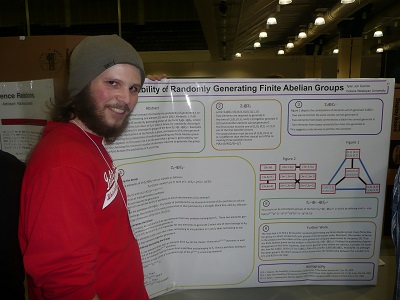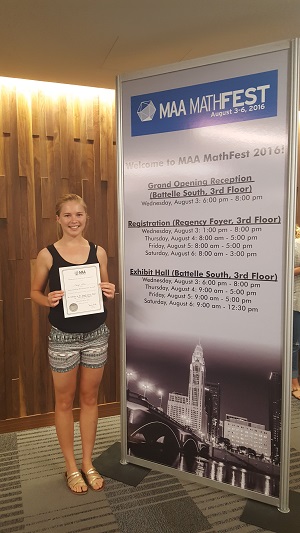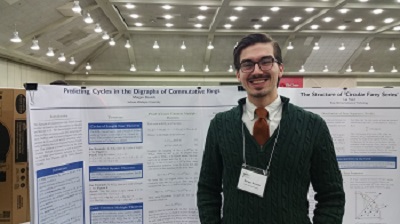
Tyler Carrico: The Probability of Randomly Generating Finite Abelian Groups
Tyler (2012) calculated the probability that randomly chosen sets of elements from certain types of mathematical groups would generate those groups. For example, the group with addition taken mod 6 is generated by the set {2,3}, since every element of the group can be written as the sum of a multiple of 2 plus a multiple of 3, but is not generated by the set {0,2,4}. Tyler investigated a more complicated group consisting of pairs of integers and found formulas for the probability that a randomly chosen subset of the group will generate the group depending on the size of the group and the number of elements chosen.
Follow-up: Tyler presented a poster on his research at the AMS/MAA Joint Math Meetings in Boston and published an article in Involve: a Journal of Mathematics.
Matthew McAndrews: Simple Connected Units Distance Graphs
Matthew (2014) constructed a previously unknown mathematical graph. A simple graph consists of any number of edges, each joining a distinct pair of vertices. The graph is called unit distance if every edge is exactly one unit in length. Prior to Matthew’s work, it was thought that there were 50 different simple connected unit distance graphs with six vertices. Matthew was able to show that there are actually 51 such graphs. His work relates to a famous unsolved math problem on the number of different colors needed to color all the points in a plane under certain conditions.
Follow-up: Matthew’s result appears in the Online Encyclopedia of Integer Sequences. Matthew is currently a Business Unit Developer at First Trust.
Kourtney Payne: Minimal Four-Color Unit-Distance Graphs
Kourtney (2017) searched for the smallest unit-distance graph with no triangles for which coloring the vertices (so that no two adjacent vertices have the same color) requires at least four different colors. She successfully found a smaller graph than the almost two-decade old previous record. (It was later discovered that someone else had found an even smaller graph, but Kourtney discovered her result independently).
Follow-up: Kourtney currently works for the United States government.
Sarah Bergen, Lauren Haffner Bartlett, Chelsea Newnum, Morgan Bounds: Digraphs of Commutative Rings
Sarah (2013), then a team of Lauren (2015) and Chelsea (2015), and most recently Morgan (2019) studied the ring operation (a,b) --> (a+b, ab) (mod n) defined on the integer lattice When this operation is repeatedly applied to a starting pair of integers and a directed graph made of successive outputs, some starting pairs eventually lead to a fixed point while other pairs end up in a finite length cycle. Through extensive computer-assisted tabulation, these students were able to form a number of conjectures on the number of cycles of given lengths depending on the natural number n. They proved several of these conjectures using results from number theory.
Follow-up: Sarah earned a master’s degree in mathematics from The Ohio State University and is currently a Mathematics Interventionist at IDEA Public Schools. Lauren earned a master’s degree in mathematics from Ball State University and is an instructor of mathematics at the University of Indianapolis. Morgan wrote a paper to appear in the Rose Hulman Undergraduate Mathematics Journal and is currently doing graduate work at The London School of Economics and Political Science.
Adam Wroughton: Training and Testing an Artificial Neural Network for Musical Note Classification
Adam (2014) investigated the ability of an artificial neural network to recognize musical notes (A through G) from sound files. A neural network is modeled after the human brain and consists of nodes joined by connections whose weights can be changed according to calculus formulas to allow the network to give the correct output to various input stimuli. Adam collected sound files of notes across several octaves played by a piano and various other instruments and applied signal processing algorithms to condense the relevant frequency information. He then used the well-known backpropagation algorithm to train neural network of various sizes to recognize which note was being played. He found the network was readily able to distinguish between two notes, and moderately successful at distinguishing between three and four notes.
Follow-up: Adam presented his work at the 2014 Miami University of Ohio annual math conference, subsequently completed a master’s degree at Purdue University in computer engineering, and is currently working at Crandall Engineering.

Caryn Willis, Matthew Johnson: Competing Species Population Models
Caryn (2015), and later Matthew (2020), generalized a previously studied discrete dynamical systems model for the populations of two competing biological species. They used the generalized model to predict which environmental conditions would allow the species to coexist and which would cause one or both species to go extinct. Using spreadsheet models, they determine a number of conjectures, several of which they were able to mathematically prove using theory from linear algebra and dynamical systems.
Follow-up: Caryn received an Outstanding Presentation Award for her talk at the 2016 MAA MathFest in Columbus. She went on to earn a master’s degree in Computational Biology from Carnegie Mellon University and is currently a Bioinformatics Scientist at UNC Lineberger Comprehensive Cancer Center. Matthew is beginning Ph.D. study in mathematics at Baylor University.
Luke Heyden: Abalone: The Game of Losing your Marbles
Luke (2017) analyzed strategies for winning the board game Abalone, in which two players move their own marbles on a hexagonal board to try to capture their opponent’s marbles. He found expressions for the total number of possible game positions depending on the board size and number of marbles. Luke was able to prove winning strategies for certain situations. For example, a player with four marbles can always win against a player with only one marble regardless of starting position. On small boards, the first player to capture the center board space will win the game.
Follow-up: Luke is working toward a Ph.D. in computational biology at Duke University.
Leah Woods: Circle Packing in an Equilateral Triangle
Leah (2019) investigated a packing problem associated with the famous mathematician Paul Erdős. Given n circles of radius 1, what arrangement fits them into the smallest possible equilateral triangle? The solution is known for the cases where n < 13, but the problem is unsolved for most larger values of n. Leah carefully went through most of the known proofs and explored one of the smallest open cases of n = 14. Some of the known arrangements are found at https://www2.stetson.edu/~efriedma/cirintri/ .
Follow-up: Leah is currently an associate chemist at Sherwin-Williams.

Morgan Bounds: Glass Billiards
For his IWU Honors College project, Morgan (2019) modified the rules for the mathematical topic of billiards (an idealization of the game of pool). Mathematical billiards studies the possible trajectories when a mass-point forever traverses a bounded arena, reflecting off the boundary at an angle equal to its angle of incidence. Morgan analyzed the more challenging case when segments of a grid of boundaries shatter and are removed after their first contact with the mass-point. He developed various conjectures and proved several theorems regarding how the sequence of shattered boundary segments depends on the starting position and direction of the mass point.
Follow-up: Morgan is currently doing graduate work at The London School of Economics and Political Science.
Brin Heyer: Solution Probabilities of Numbrix Puzzles
Brin (2020) studied some mathematics behind Numbrix puzzles, created and popularized by Marilyn vos Savant. Solving a Numbrix puzzle consists of placing consecutively numbered chips in adjacent squares on a rectangular grid on which some chips are already placed to begin. The puzzle creator must carefully choose the numbers and positions of the starting chips so that the puzzle has a unique solution. Examining various board sizes, Brin developed formulas for the probabilities that placing randomly chosen starting chips in randomly chosen positions on the board will result in a puzzle with a unique solution.
Spencer Bye: Tiling Deficient Rectangle
Spencer (2020) investigated a new type of mathematical tiling problem. Tiling a given geometrical shape by specified figures refers to completely covering the shape by non-overlapping copies of the given figures (tiles). A honeycomb, for example, is an example of a tiling of the plane by regular hexagons. Spencer worked with shapes and tiles both made up of multiple adjacent unit squares. Specifically, his shapes were integer-dimensioned rectangles with two unit squares removed. He used eight tiles, chosen with special properties, each made of five unit squares. Spencer proved some results regarding which dimensions of such shapes can be tiled with these tiles.
Mara Smith: Nonlinear Lotka-Volterra Competition Models
Mara (2022) further generalized a dynamical systems model for the populations of two competing biological species. Since its development in the 1920's, the Lotka-Volterra model has been modified by several researchers to apply to different types of biological interactions; these generalizations often require new methods of mathematical analysis. Mara developed her own generalization and was able to rigorously prove several mathematical results that almost completely determine which environmental conditions will allow the species to coexist and which would cause one or both species to go extinct. She used a variety of mathematical theory to confirm results seen in her numerical simulations.
Follow-up: Mara's paper was subsequently published in the Ball State Undergraduate Mathematics Exchange
